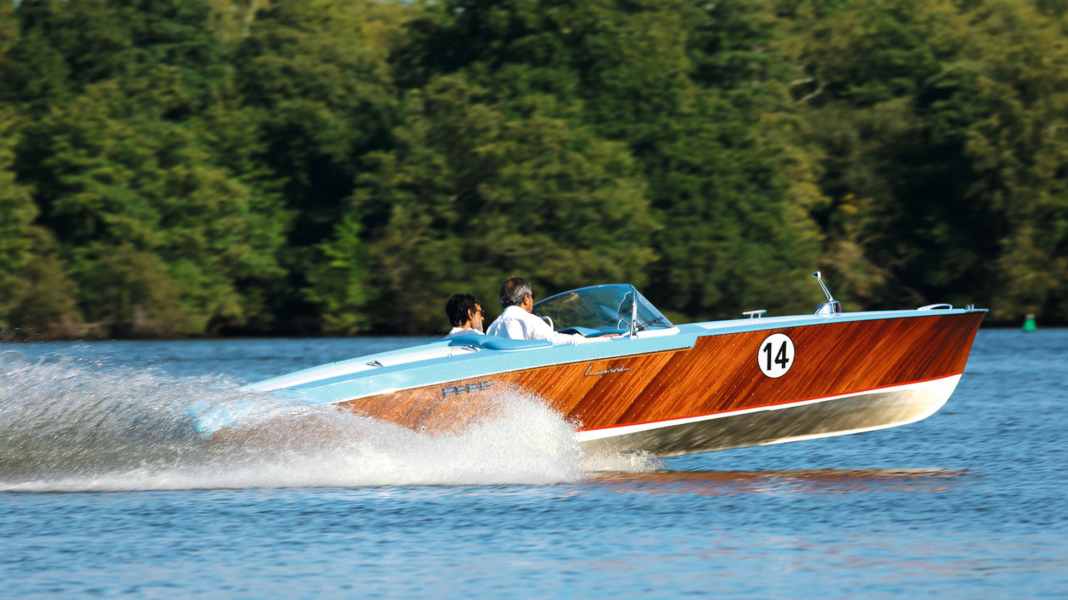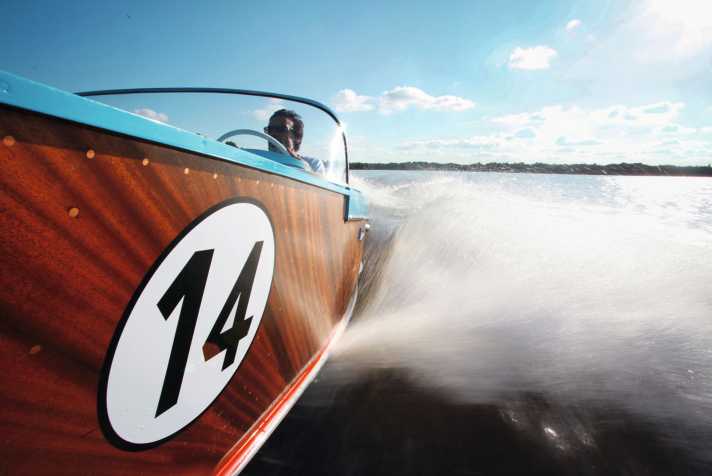
Ever since Woody Allen's film "Manhattan" was released in 1979, George Gershwin's famous "Rhapsody in Blue" has mainly been associated with the New York cityscape. But why not transfer its sounds to another glamorous film set in Paris? When Frantz Liuzzi began building beautifully light dinghies and canoes in Neuilly in 1937, he would never have dreamed that just two decades later he would be supplying classy runabouts to film stars such as Errol Flynn. After his canoes had won many trophies on the challenging rapids of France's wild rivers, including during the Second World War, when muscle power was more available than petrol for nautical sports activities, Liuzzi started a small production of inboard runabouts in the late 1940s, mainly powered by Italian BPM engines from Milan.
His first successful model, called France-Craft, clearly referred to the world-famous Chris-Craft series. But unlike his mentor in Algonac, in the US state of Michigan, Liuzzi's wooden hulls had the particularity of being cold-moulded, a rather unusual technique at the time, with double or triple layers according to the original patent "Monocoque F.L." (where the initials stand for his own name). Liuzzi relied on this speciality when he advertised nothing less than "the most luxurious, fastest and strongest racing boat hulls in the world". He could certainly not be accused of a lack of self-confidence.
More information? The classic report on the Liuzzi Star 6 with many more pictures can be found in BOOTE issue 08/2021 from 14/07/2021 at newsstands or online at Delius Klasing Shop.

It was indeed difficult to disagree with this passionate racing driver and master builder, an adopted Parisian who was even more chauvinistic than a local: the endless list of international racing victories and world speed records that Liuzzi recorded in his logbook from 1950 onwards justified his attitude and quickly made him a reference when it came to orders for a new runabout, placed by a very demanding clientele of the noble residential districts and immaculate bespoke suits.
His fame soon extended from the capital down to the Riviera, to exclusive clubs such as the MYCCA, the Motor Yacht Club of the Côte d'Azur and Monte Carlo. One of his runabout models was even named "Prince de Monaco". From the canoe stern to the fins of a Cadillac, Liuzzi's design was always closely aligned with the trends of the time - and thus with the ideas shared by gentleman drivers, film stars and well-heeled industrialists when it came to sporting performance and beautiful images in equal measure. Frantz Liuzzi's stand at the Paris Boat Show thus became an annual rendezvous, a fashion week for boating, at which even the President of the Republic did the honours.
It was also a time when the press was throwing a lot of light on the boat scene, and the Parisian master builder, whose office was just a few minutes away from the Champs-Élysées, knew how to capitalise on this free publicity: Because the chic Rue Soyer housed a workshop the likes of which are rarely found in such central residential neighbourhoods. Let's try to imagine what Neuilly looked like back then, with its wide avenues and shady side streets: There weren't too many cars parked along the quiet pavements, a posh Delahaye perhaps, a gleaming Jaguar or an impressive Oldsmobile - and a few more modest Renault and Simca in between. At the end of the fifties, less than twenty per cent of French households owned a car. Not to mention a motorboat, the symbol of luxury.
In the boat workshop on the ground floor of a residential building, a handful of workers were busy building one hull after another under the constant watchful eye of Monsieur Luizzi. Meanwhile, in a small office nearby, his secretary was flying her fingers over the keys of a typewriter with the utmost concentration. Because the piles of carbonless paper that were fed in did not forgive any oversights and reproduced every mistake. VAT, introduced in 1954, was not yet levied on individual items such as the Liuzzi Star 6 Runabout, a genuine luxury item worth 3.9 million old francs (the new franc would not arrive until 1963). By comparison, a brand new Citroën DS was already available for the sum of 930000 francs.

The French automobile magazine "Moteurs" described Frantz Liuzzi as unique in his craft, a cross between the racing driver and sports car designer Amedeo Gordini and the fashion designer Christian Dior. His boats were expensive and their production was limited. It is likely that between 1948 and 1967, when he died aged just 62, fewer than one hundred units left the factory floor. One of Liuzzi's great talents was to develop further variants based on an initial drawing in order to meet the customer's wishes. In this respect, it can be said that each construction number was unique, even though the model was basically part of a so-called series production catalogue that included boats with lengths ranging from 4.80 to 6.20 metres. The 6.20 metre long Star 6, powered by a 255 hp BPM Super Atlantic V6, shone particularly brightly in Liuzzi's skies. A special model was offered as the "Type Champion du Monde".
In 1961, a certain Jacques Arnilhac, an architect from the Bordeaux region and a dedicated gentleman racer, ordered a Star 6, which was to become a champion in the Runabout International Class IV. At the wheel of his imposing new vehicle, Arnilhac, a good driver who could win outboard and inboard races, came first in the Monaco Trophy in 1962, one of the most important events in the annual racing calendar. Apart from this fame, however, very little is known about the life of number "14". The fast but comfortable boat was probably used by the whole family at weekends and during holidays in the 1960s. But soon afterwards, the golden age of amateur racing came to an end - and like many other wooden boats of its kind, the Star 6 became obsolete and eventually disappeared completely from the scene.
This only changed about thirty years later, when vintage and classic boats began to attract renewed interest, this time from enthusiasts and collectors: in 1990, a certain M. Jean-Marie Rolland, a car electrician from the Drôme region in south-west France, discovered a badly battered wooden boat in a lorry scrapyard, but its elegant lines still made an impression. The owner of the scrapyard tried to sell the battered hull for a very high price. He insisted that it was a valuable "variant of a Riva".
A year later, the scrapyard went bankrupt and Rolland seized the opportunity to get the boat at a much more favourable price, including the engine that was still in it. However, as the new owner initially had too little time himself to tackle the restoration because his day job and building a house at the same time were taking up all his time, the runabout was temporarily stored in the garden. However, he began to research the history of his new acquisition - even if historical sources were still rare, as interest in this type of collector's item was still in its infancy.
But the search continued, step by step, and after four or five years, J.M. Rolland finally discovered the name of the first owner and Monaco winner, Jacques Arnilhac. In 1995, he removed the panelling to examine the boat's skeleton. He also visited the BPM factory in Italy to get parts and advice to bring the engine back to life. As soon as the house was finished, things really got going in 2000: the hull was restored in a friend's warehouse and the engine was rebuilt in the garage at home. In 2006, it was restarted for the first time in decades and soon after, a year later, the Star 6 was back in its element. There was still a lot to perfect, but the performance was impressive from the very first test run.
They say that love works wonders, but there is no doubt that it is above all the great dedication and craftsmanship of J.M. Rolland, who carried out almost all the work himself, that has led to a marvellous result. It hardly needs mentioning that the Star 6, with an auto-electrician as owner, has also been completely rewired. The only expert job undertaken by another professional was the new upholstery work on the seats - a birthday present from his wife.
After several years of joy with family and friends on board the boat, during which he took part in major classic car meetings such as the Monaco Classic Week, a pilgrimage more than fifty years after the 1962 victory, Jean-Marie Rolland has sold his Liuzzi to a new, happy owner: Philippe Tancrel, who lives in the west of France. There, the deep, powerful and somewhat brutal sound of the BPM Super Atlantic V6 has become increasingly familiar to his neighbourhood on the tranquil River Erdre. It is a reminiscence of the 1950s and 1960s. Even back then, canoes, dinghies and other small boats of all kinds travelled there without being overly impressed by those loud powerhouses like the Star 6 that were driven by the rich and famous.

